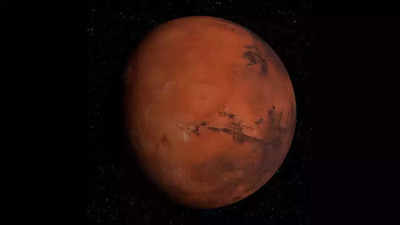
Recent findings from China’s Zhurong rover suggest that Mars once hosted an ocean, significantly altering our understanding of the planet’s ancient environment. Data gathered from the rover, along with information from orbiting spacecraft, reveals geological features on Mars that resemble those found along coastlines on Earth. These features, including sediment channels, mud volcanoes, and troughs, point to the presence of a large body of water in the past.
This discovery supports the theory that Mars, once a potentially habitable planet with a warm atmosphere, may have had conditions conducive to microbial life. The study, published in Scientific Reports, offers new insights into Mars’ evolutionary history and adds weight to the possibility that liquid water once flowed across its surface.
Zhurong rover discovers geological features indicating ancient coastline
Findings from China’s Tianwen-1 Orbiter, NASA’s Mars Reconnaissance Orbiter, and Zhurong point to a period when Mars may have been cold and dry, with a much thinner atmosphere, yet still harboured a significant body of water. Evidence of ancient coastlines, including troughs, sediment channels, and mud volcanoes, hints at both shallow and deep marine environments on Mars.
“We estimate that Utopia Planitia flooded around 3.68 billion years ago, with the ocean likely freezing over in a short geological period,” said Bo Wu, a planetary scientist from Hong Kong Polytechnic University and lead author of the study published in Scientific Reports. The ocean seems to have vanished by around 3.42 billion years ago. The water, likely laden with silt, contributed to the layered deposits on the Martian surface, according to co-author Sergey Krasilnikov.
Mars’ transition from habitability
Mars formed around 4.5 billion years ago, like the other planets in our solar system. This ancient ocean’s presence suggests that Mars may have once been transitioning from a more habitable environment. “The presence of an ancient ocean on Mars has been proposed and studied for several decades, yet significant uncertainties remain,” Wu added. “These findings not only provide further evidence to support the theory of a Martian ocean but also present, for the first time, a discussion on its probable evolutionary scenario.”
Water is a critical component for life, and the possibility of an ancient Martian ocean hints that Mars might have once supported microbial life. “At the beginning of Mars’ history, when it probably had a thick, warm atmosphere, microbial life was much more likely,” said Krasilnikov.
Zhurong rover’s mission and legacy
Zhurong, named after a mythical Chinese fire god, started its mission with six scientific tools in May 2021 and went into hibernation a year later, likely due to dust accumulation. The rover surpassed its original three-month mission timeline. Meanwhile, researchers continue to explore Mars’ water history. A separate study, based on seismic data from NASA’s InSight lander, suggests a massive liquid water reservoir might exist deep within fractured rocks beneath Mars’ surface.
Also Read | NASA’s Parker Solar Probe set for historic final Venus Flyby before record-breaking sun encounter
